Digital wayfinding options expand for health facilities

New digital wayfinding solutions are available to help visitors, patients and staff navigate their way through the maze-like environments of hospitals and other health care facilities.
These innovations include digital wall signage, kiosks and mobile wayfinding solutions. Driving much of this development is digital signage software, which is used to create, manage and deliver content to screens, video walls and kiosks.
Still, hospitals pose many challenges to vendors when it comes to planning and installing digital wayfinding systems.
The complex nature of hospitals often translates into a confusing journey for visitors. Some areas are intentionally hidden from view. Providers also must take into account people with disabilities; they require different routes based on individual capabilities.
Content is king
Most hospitals plan for the hardware and software, but not for the wayfinding content, according to Lillyan Wamaitha, marketing manager at Mvix Digital Signage, Sterling, Va. “What is the new content going to be, where is it coming from, who is managing it and how often will the screens be updated? Localization also is an issue. Off-campus facilities need localized and personalized content. How will that happen?”
Randy Cooper, founder of Cooper Signage & Graphics Inc., Loganville, Ga., says a systems approach to wayfinding, with many communicative tools working together, is the best solution. Cooper offers the following advice:
- Implement unified (simplistic) terminology and a trained staff to communicate.
- Post information online (unified in content, terminology and visuals) to help orient patients and their escorts. Utilize every tool available such as website links, maps, videos and printed visitor guides. Upload videos of what to expect upon arrival to YouTube and other social media outlets.
- Use static (traditional) signage. “Even if a GPS [global positioning system] guides people to the site, they still want to see signage to reinforce them along the path,” Cooper says.
- Once inside a facility, continue the process with placemaking and experiential graphics.
- Use digital media of every form — GPS, kiosks, digital displays, patient room identification and care information, and more traditional vehicles such as menus and entertainment.
- Historically, Cooper adds, digital signage has presented four major obstacles to wayfinding providers: defining what is needed and practical; controlling costs to implement and maintain systems; improving methods of geographic locating; and getting systems to work together effectively.
Often it comes down to hardware, according to Robert Johnson, vice president of sales at Concept3D, Denver. “Beacons, Wi-Fi systems or even signage that does not match the digital experience can cause confusion for the end user,” he says. “Beacons are great for accuracy, but they can cost four times that of a possibly less accurate, existing Wi-Fi network.”
Multiple technologies
Wamaitha notes that the way people consume content has changed. They have more screens at their disposal; they like visuals more than text; and they are impatient and want things quickly.
“Hospitals have to adapt their messaging to stay relevant and provide a good experience,” Wamaitha says. “They can do this by using multiple technologies — digital signage, Bluetooth, mobile apps and interactive kiosks — to create a comprehensive wayfinding tool. This will provide quick, personalized information sent in short bursts that is easily understood.”
Wayfinding kiosks can be used for many applications and can increase return on investment if used the right way across an organization. Screen placement also can impact how and when a screen is used, according to Alex Singer, sales executive at Four Winds Interactive, Denver.
“Hospital administrators need to understand all ADA requirements and take the time to find high-traffic areas so that the screens are useful,” Singer says. “Many challenges revolve around COVID-19 and how it is impacting the way we communicate information and move around a facility.”
Among various digital wayfinding technologies recently introduced to the health care market, much of the innovation emanates from digital signage software, which is used to create, manage and deliver content to screens, video walls and kiosks. 3D visualization and voice user interface (VUI) are among new capabilities. The latest wayfinding systems also take into account the COVID-19 pandemic, and thus promote social distancing.
Mvix Digital Signage recently launched “Wayfinding-as-a-Service,” which is designed to simplify wayfinding for mid-sized hospitals that need simple, yet functional, wayfinding in a post-pandemic world. “Wayfinding can be complicated, with options such as voice-activated search, detour rerouting, turn-by-turn directions and private access,” Wamaitha says. “These options are great to have, but they’re expensive and out of reach for mid-sized enterprises.”
The Mvix wayfinding service includes a touch-capable map, a set amount of content to display on home screens, floor plan designs and route scheduling. Other features include mobile integration, indoor and outdoor wayfinding support, and monthly content updates.
Gozio Health, Atlanta, has launched a “Fast Track” mobile solution, a more focused version of its full Gozio platform, which deploys in days. Features include interactive wayfinding that directs patients to a specific location, a mobile dashboard that displays critical information, and integration with telehealth, virtual triage and electronic health records. The platform can triage coronavirus patients and communicate safety procedures to patients seeking elective care.
Concept3D offers a web-based platform. “With our content management system, health care partners are able to integrate other web-based applications such as mobile apps, scheduling integrations and wayfinding, or integrate into their web-based software, depending on the need,” Johnson says. The company recently introduced wheelchair-accessible wayfinding routes.
Visix Inc., Peachtree Corners, Ga., offers voice-activated wayfinding for custom touchscreen projects. A VUI uses natural language processing to answer requests just like Alexa, Siri or Google Assistant. Users simply ask the screen where to find something, and it shows them the destination and directions they need. Using a VUI not only minimizes the spread of germs from touchscreens, it also mimics the visitor’s at-home experience.
In the wake of COVID-19, Visix has added touchless interactivity to its digital signage software content management system (CMS) so users can make any display interactive — no touchscreen, third-party software or internet connection is required. “Users simply build a set of slides for the screen, and enter trigger words and common requests, then map those keywords to show the appropriate content,” says Debbie DeWitt, marketing communications manager.
Keywest Technology, Lenexa, Kan., offers Breeze digital signage software. Cloud-based and accessible through a desktop web browser, Breeze makes it easy to create interactive playlists that allow patients, visitors, staff and medical personnel to find their way around a medical campus, according to Nick Allen, director of software development. “Reducing kiosk congestion and providing people with personalized information while maintaining their privacy is a key to success. The faster we can get a person off the kiosk and onto their smartphone, the better we serve them,” he says.
Everbridge, Burlington, Mass., continues to expand the capabilities of its wayfinding solutions, especially during the COVID-19 pandemic when hospitals are reorganizing the flow of their facilities. The company has added features such as preparation reminders about new COVID-19 procedures and visitation policies, re-routing patients to screening locations, and creating one-way digital routes to ensure physical distancing. “We want to make the patient feel safe about returning to the hospital setting, now that elective procedures have resumed,” says Eric Chetwynd, general manager of health care solutions. “For many health systems, returning elective procedures are the key to their revenue recovery.”
In response to increased health and safety needs within public spaces, Four Winds Interactive has rolled out new digital signage solutions. One solution integrates a touchless hand sanitizer with a small form-factor screen. This allows hospitals to communicate critical information while providing access to health and safety resources. Another solution combines digital signage with a mask dispenser as well as a touchless hand sanitizer dispenser. The company also offers portable digital signage options that make it easy to deploy signs quickly whenever needed.
Among new web-based wayfinding products that help visitors prepare for a trip to the hospital, Everbridge’s mobile and web-based wayfinding interface allows patients to set their destination from home, see local services (e.g., ATMs and food courts) on their route and complete policy alerts (i.e., questionnaires). They can take a tour via a 3D campus map, drill down into the specific building where they have an appointment, and follow turn-by-turn routes on their mobile device.
Carousel Digital Signage, Minneapolis, has added the concept of “express players” to its digital signage software, according to J.J. Parker, CEO. The new capability is designed to extend the reach of classic digital signage. This includes the ability to embed the same content that is on kiosks directly into a website or display it on tablets with “app-less” deployment.
Visix has explored wayfinding apps in the past, but most clients opt for on-site wayfinding, according to DeWitt. “However, since we design all of our interactive wayfinding projects in HTML5, users can access it on any device,” DeWitt says. “By simple adding a quick response code to the screen design, they can download the entire wayfinding system onto their mobile device. We also can include short message service options to let people text turn-by-turn directions right to their mobile device from interactive kiosks.”
Off-site challenges
Vendors face challenges when planning and installing wayfinding systems in off-campus health care facilities, a fast-growing market segment. Parker of Carousel Digital Signage sees two major issues. The first involves the connectivity of the wayfinding/digital signage CMS.
“We offer a cloud-hosted version of our CMS, which lessens the IT burden to deploy,” Parker says. “We also support nontraditional media players — such as Apple TVs — for content, so smaller facilities can get more cost savings out of these devices.” The second challenge is making sure the content at remote facilities is timely and relevant to the staff and patients. “Giving staff access to create and update content on displays and kiosks at the local level is critical,” Parker says.
At remote locations, it is important to have a platform that can be updated and previewed even if the main content editor is not present, according to Singer of Four Winds Interactive. It is essential to be able to push new content to any location and remotely confirm the content is deployed correctly.
“Our platform enables access tailored to the needs of the specific organizational role, giving content contributors from other locations the ability to program content on their screens,” Singer says. “It is important to allow off-campus facilities to have some autonomy to determine what content is relevant to that specific space.”
For connected clinics or off-campus facilities, the major challenge is helping patients get from one location to another, locate parking and get to their appointment with the least amount of travel anxiety.
“With connected maps, we’ve made it easy for our clients to provide clear directions to available parking lots,” says Johnson of Concept3D. “We also provide multi-level wayfinding that includes distance and time estimates to help prepare patients for their next visit.”
Expanding options
People will always need assistance to navigate through health facilities, but the future is about expanding the ways they can search for, interact with and follow directions, says DeWitt of Visix Inc.
“We’ll likely see screens that talk back, tie into personal assistants on mobile devices and walk you right to your destination with turn-by-turn guidance like a GPS,” DeWitt says.
Neal Lorenzi is a freelance writer and regular contributor based in Mundelein, Ill.
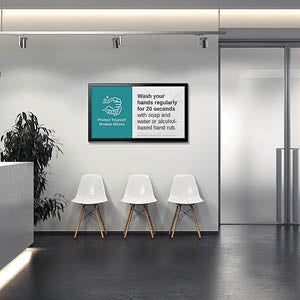
GETTING AROUND
Carousel Cloud software helps hospitals communicate important messages in waiting areas, walkways and other public-facing spaces. Carousel Digital Signage
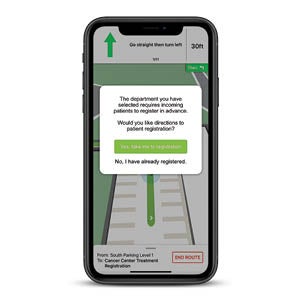
HYPER LOCAL
Zone-based alerts send targeted notices to staff, patients and visitors within a certain area, providing information based on the user’s location. Everbridge
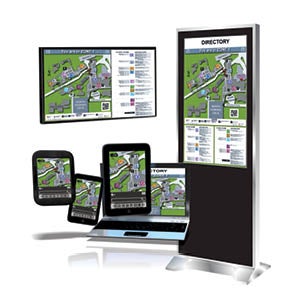
SMART SOLUTION
Intelligent content and visuals across multiple output devices, print media and static signage help project a unified message. Cooper Signage & Graphics Inc.
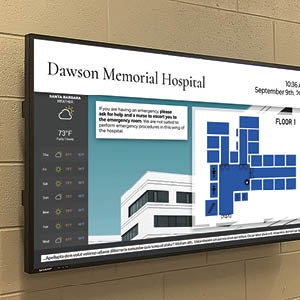
PRACTICAL PREFERENCE
This “Wayfinding-as-a-Service” offering makes navigating a hospital simple and affordable. Mvix Digital Signage
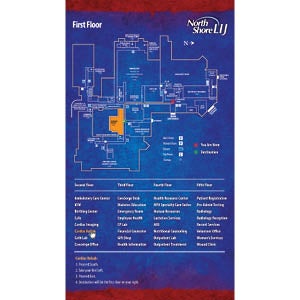
FINDING IT EASY
Breeze digital signage software makes it easy to create interactive playlists that allow people to find their way around a medical campus. Keywest Technology
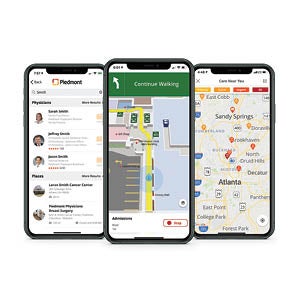
ENGAGING OPTION
This digital front door platform with intuitive indoor navigation engages with patients at each step of the journey before, during and after care. Gozio Health
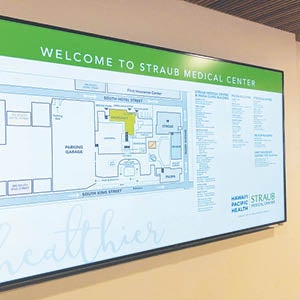
VIEWERS’ CHOICE
AxisTV digital signage software lets hospitals choose from static, interactive or voice-activated wayfinding on screens. Visix Inc.
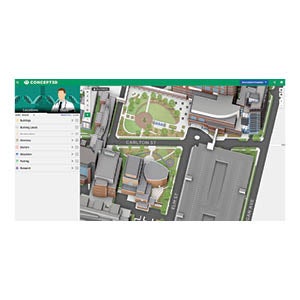
VIRTUALLY REAL
This platform brings a campus to life in 3D, helping users find the campus, locate parking and then find the best route to their destinations. Concept3D
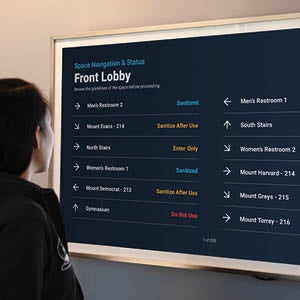
NO TOUCH
This directional wayfinding application enables hospitals to provide people with easy, contactless wayfinding information. Four Winds Interactive




